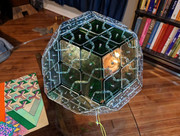I am quite experienced with lasercutting paper models. it's exhilirating! not only is the precision perfect and nearly instantaneous but the scoring can be done in many ways with differing qualities. multiple light passes that deviate slightly off the score line can actually bevel your score which is a luxury for thicker weight paper and small or pointy parts. also dotted lines cut into or thru the paper work well. intricate tabbing and slotting approaches can eliminate the need for glue. faces can be cut away with intricate patterns that wrap around edges creating higher orders of dimensionality. nested concentric shapes could be revealed this way with a contrasting pop of color. you can even engrave photographs onto paper (this takes some skill and proper photo quality) i use my laser for surface finishes, patterning, tactile effects, distressing, hidden patterns by engraving the inside surface and revealing them by placing a light inside. honestly, paper is cool but acrylic constructions are another level. not to mention wood, cork, latex, diffraction grating, irridescent films, cardboard, circuitboards, delrin, acetate, leather, garbage, pumpkins, chocolate, just about anything you could imagine.
what I would love from stella is a scalable 2D vector output for the nets. preferrably .svg or even .ai as that is the graphics program (illustrator) that I use to group and color my paths and assign stroke weights, etc.. PDF works but is not ideally formatted and contains errors and fails frequently. for my machine cut lines are only recognized if they are RGB red and .001" stroke weight. although i could assign more colors to use differing parameters within a single job if needed. engraving can be done as a bitmap with chosen dithering patterns or as greyscale values correlating to amount of laser power for 3d depth engravings. (yes, you can 3d engrave paper. especially two tone papers or paper with an alternate core color.) all these post-processing assignments are why you cant just print directly to the laser. there's even another print-driver program that communicates with the laser after recieving your formatted file from illustrator. every mfr. has their own workflow and requirements but for an expensive large professional non-chinese machine this is fairly standard.
I use an 80watt co2 laser made by Trotec called the Speedy 360. it has a work area of approximately 32 x 20" (813 x 508mm to be exact)
Hey Robert- I'd be happy to trade some lasering for a stella4d license. I've been eyeing the program for years waiting for better vector output, but i reference the knowlege contained in the demo regularly to construct my models. that would also confirm if i can squeeze what i need out of it! -dave

